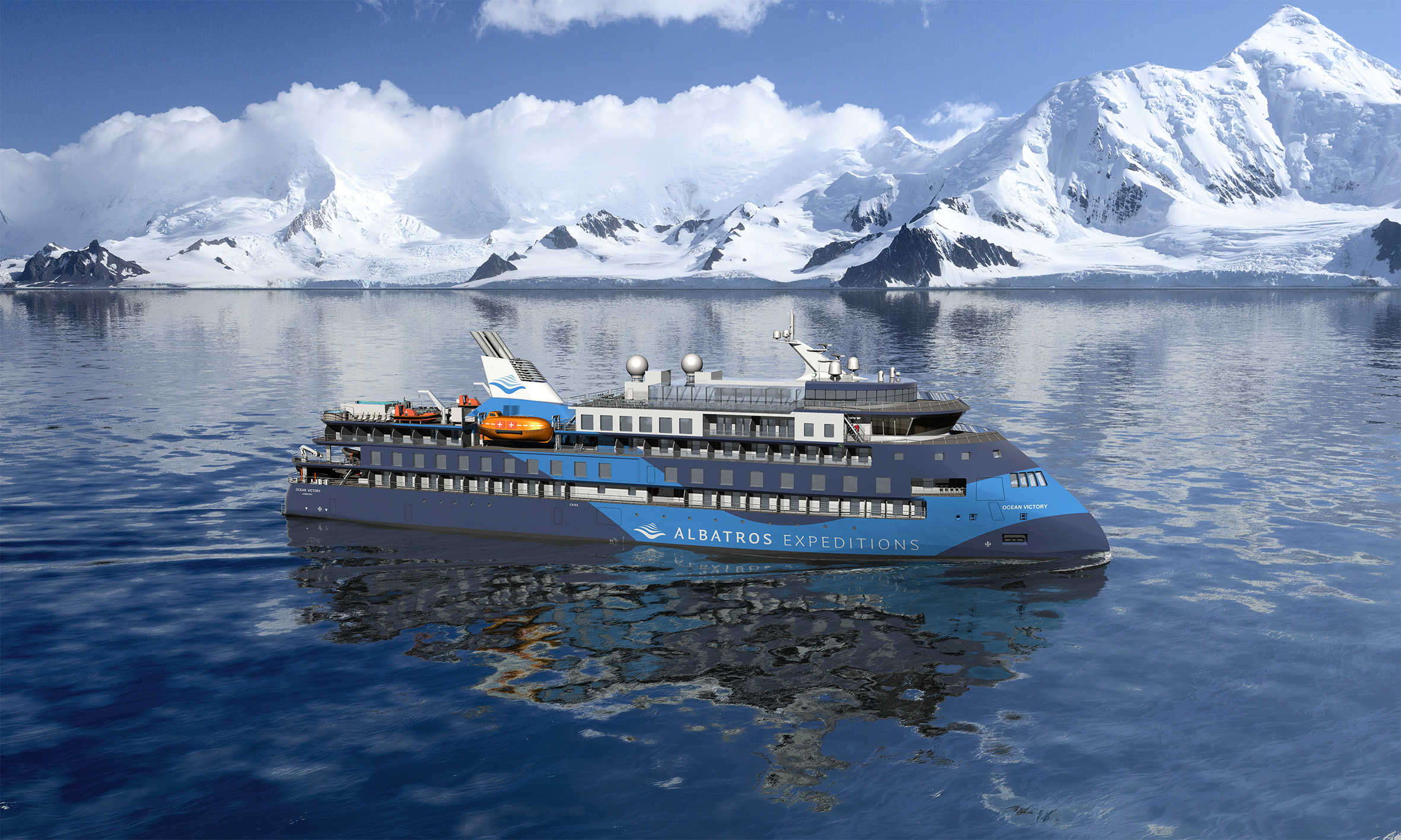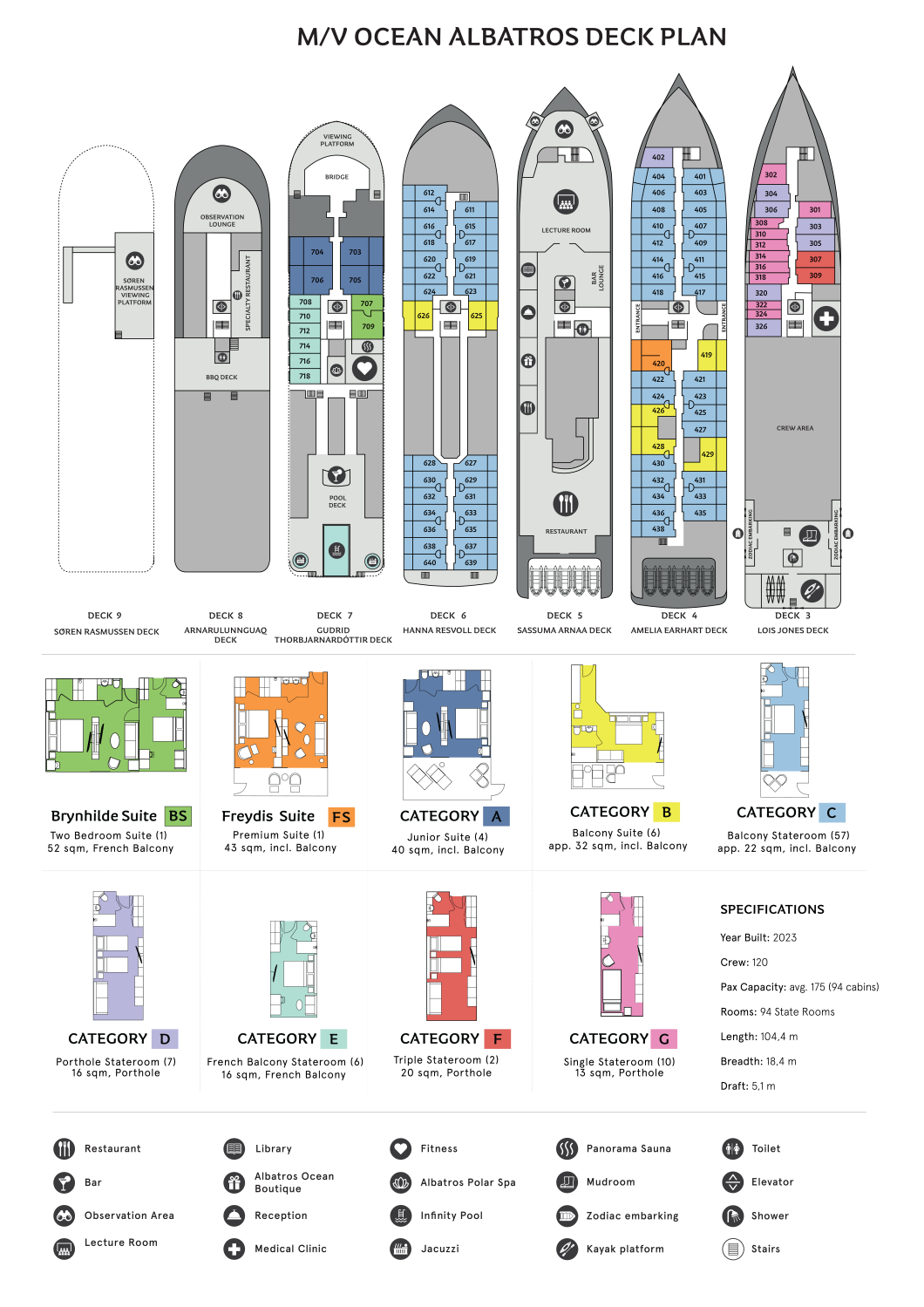Greenland Disko Bay: Ocean Albatros
Greenland
Navigating along Greenland’s old intercoastal routes, we can indulge in the multitude of wonders, including “Iceberg Capital of the World”, Ilulissat, and the nearby UNESCO-protected Icefjord. Visit the small town of Qeqertarsuaq on mountainous Disko Island where we can experience the “Kaffemik” tradition in the community house, and we’ll cruise close to the calving glacier of Eqip Sermia. Even make a call to the Polar Circle settlement of Itilleq. While overnighting in Iceland, have the opportunity to experience the island nation’s unique nature, as well as centuries-old history and culture
Travelling by sea is still the best way to experience Greenland. The places most worth seeing are situated along the dramatic coastline: small and colourful houses resting on the steep mountainsides down to a fjord, giant glaciers producing enormous icebergs, meanwhile, whales and seals play in the sea. And only a few minutes' hike away, you will find yourself totally isolated, surrounded by wilderness. The people of Greenland live along the coast in small towns and settlements – in summer, only accessible from the sea. Their culture, architecture and living conditions are enriched and limited by the harsh nature of the Arctic. On our town visits, you can meet hospitable Greenlanders and learn more about the Inuit culture.
But global warming is changing Greenland’s Arctic environment at an alarming rate. On this 8-day voyage to Disko Bay and Uummannaq, we follow the tracks of scientists and decision-makers to see with our own eyes the retreating glaciers and gasp at the thought of losing them. During our third day of the cruise, we visit the Danish Research Station on Disko Island. The expedition concept means we will utilize Zodiacs for beach landings and enjoy nature hikes to get close to receding glaciers. We reach our northernmost point at the fabulous town of Uummannaq. Before heading southbound, we attempt to make a Zodiac landing at Eqip Sermia, a giant retreating glacier and visit Ilulissat, the 'Iceberg Capital of the World'. Our last visit is to the small Inuit settlement of Sarfannguit. Back in Kangerlussuaq, we disembark and make our way back to Iceland or Denmark.
Unforgettable experiences await you in Greenland!
Stewart's Take
Unforgettable experiences await you in Greenland!
Overview
Navigating along Greenland’s old intercoastal routes, we can indulge in the multitude of wonders, including “Iceberg Capital of the World”, Ilulissat, and the nearby UNESCO-protected Icefjord. Visit the small town of Qeqertarsuaq on mountainous Disko Island where we can experience the “Kaffemik” tradition in the community house, and we’ll cruise close to the calving glacier of Eqip Sermia. Even make a call to the Polar Circle settlement of Itilleq. While overnighting in Iceland, have the opportunity to experience the island nation’s unique nature, as well as centuries-old history and culture.Scrolling is disabled on map, please click to enable.
M/V OCEAN ALBATROS

The brand-new luxury infinity vessel Ocean Albatros is one of the most modern small ship vessels in the world. This stylish cruise ship is ideally suited to small-ship expeditions, with a total of 93 comfortable cabins for guests, all with a view of the ocean, 90% with a balcony, even a suite with a French balcony! Ocean Albatros is deployed and dedicated to varied Arctic polar voyages. With the highest Polar code 6 and Ice class 1A, Ocean Victory is the ideal vessel for small-ship cruising due to her sturdy construction and X-BOW® – Infinity class, which provides high stability in rough weather and allows for the smoothest movements on high waves, and a Solas 2012 classification, which facilitates a safe return to port. The vessel will have more than a 50% lower carbon footprint than traditional expedition vessels and be one of the most environmentally friendly, implementing the Green Initiative Program, ensuring both absolute comfort and sustainability for our guests. Ocean Albatros will also offer a unique panorama sauna, and a total of 12 dedicated solo travel cabins without a single-supplement. Like it's sistership the Ocean Victory it offers two restaurants, a wellness area, an Albatros Nordic Bar, an open deck dining facility, a modern lecture lounge, and other state-of-the-art amenities.

- English-speaking Guides
- Flights Keflavík – Kangerlussuaq round trip
- Local transport in Kangerlussuaq on day 1
- City walks in Sisimiut, Qeqertarsuaq, Ilulissat, and Itilleq
- Museum visits in Sisimiut, Qeqertarsuaq and Ilulissat
- Church visits in Qeqertarsuaq and Ilulissat
- ‘Kaffemik’ visit in Qeqertarsuaq
- Briefings and talks by Tour Leaders
- 5-day cruise with full board
- Coffee, tea and water on the ship
- Taxes and tariffs
- Single room supplement and cabin upgrades
- Meals not on board ship
- Beverages other than coffee, tea and water
- Tips for ship crew (approx. 13.5 USD per day per participant)
- Personal expenses
- Day 4 Flightseeing by fixed wing aircraft or helicopter over icebergs.
- Day 5 From Kangerlussuaq to Reindeer Glacier by 4WD buses

Tour Dossier
Greenland Disko Bay: Ocean Albatros

Onboard this Ocean Albatros Greenland cruise alongside glacial landscapes, whales, seabirds and a multitude of fascinating settlements
File Creation date: 2024-04-20 - for updated information and dates and prices see the following page:
http://expeditionsonline.com/tour/greenland-disko-bay-ocean-albatros_347

Greenland Disko Bay: Ocean Albatros
Duration: 8 days
Location: Greenland
Available: August
Start: Kangerlussuaq, with flight from Iceland or Copenhagen
Finish: Kangerlussuaq, with flight to Iceland or Copenhagen

Highlights

Itinerary
Navigating along Greenland’s old intercoastal routes, we can indulge in the multitude of wonders, including “Iceberg Capital of the World”, Ilulissat, and the nearby UNESCO-protected Icefjord. Visit the small town of Qeqertarsuaq on mountainous Disko Island where we can experience the “Kaffemik” tradition in the community house, and we’ll cruise close to the calving glacier of Eqip Sermia. Even make a call to the Polar Circle settlement of Itilleq. While overnighting in Iceland, have the opportunity to experience the island nation’s unique nature, as well as centuries-old history and culture





Ship Information
M/V OCEAN ALBATROS

The brand-new luxury infinity vessel Ocean Albatros is one of the most modern small ship vessels in the world. This stylish cruise ship is ideally suited to small-ship expeditions, with a total of 93 comfortable cabins for guests, all with a view of the ocean, 90% with a balcony, even a suite with a French balcony! Ocean Albatros is deployed and dedicated to varied Arctic polar voyages. With the highest Polar code 6 and Ice class 1A, Ocean Victory is the ideal vessel for small-ship cruising due to her sturdy construction and X-BOW® – Infinity class, which provides high stability in rough weather and allows for the smoothest movements on high waves, and a Solas 2012 classification, which facilitates a safe return to port. The vessel will have more than a 50% lower carbon footprint than traditional expedition vessels and be one of the most environmentally friendly, implementing the Green Initiative Program, ensuring both absolute comfort and sustainability for our guests. Ocean Albatros will also offer a unique panorama sauna, and a total of 12 dedicated solo travel cabins without a single-supplement. Like it's sistership the Ocean Victory it offers two restaurants, a wellness area, an Albatros Nordic Bar, an open deck dining facility, a modern lecture lounge, and other state-of-the-art amenities.

Greenland Disko Bay: Ocean Albatros
For the latest, up-to-date departure dates and prices please refer to the tour page:
http://expeditionsonline.com/tour/greenland-disko-bay-ocean-albatros_347
Included
- English-speaking Guides
- Flights Keflavík – Kangerlussuaq round trip
- Local transport in Kangerlussuaq on day 1
- City walks in Sisimiut, Qeqertarsuaq, Ilulissat, and Itilleq
- Museum visits in Sisimiut, Qeqertarsuaq and Ilulissat
- Church visits in Qeqertarsuaq and Ilulissat
- ‘Kaffemik’ visit in Qeqertarsuaq
- Briefings and talks by Tour Leaders
- 5-day cruise with full board
- Coffee, tea and water on the ship
- Taxes and tariffs
Excluded
- Single room supplement and cabin upgrades
- Meals not on board ship
- Beverages other than coffee, tea and water
- Tips for ship crew (approx. 13.5 USD per day per participant)
- Personal expenses
- Day 4 Flightseeing by fixed wing aircraft or helicopter over icebergs.
- Day 5 From Kangerlussuaq to Reindeer Glacier by 4WD buses

General Terms and Conditions
Expeditions Online Newsletter
Sign up to be an Expeditions Online insider and receive info on exclusive deals, discounts and more!